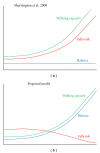Physical therapy adjuvants to promote optimization of walking recovery after stroke
- PMID: 22013549
- PMCID: PMC3195278
- DOI: 10.4061/2011/601416
Physical therapy adjuvants to promote optimization of walking recovery after stroke
Abstract
Stroke commonly results in substantial and persistent deficits in locomotor function. The majority of scientific inquiries have focused on singular intervention approaches, with recent attention given to task specific therapies. We propose that measurement should indicate the most critical limiting factor(s) to be addressed and that a combination of adjuvant treatments individualized to target accompanying impairment(s) will result in the greatest improvements in locomotor function. We explore training to improve walking performance by addressing a combination of: (1) walking specific motor control; (2) dynamic balance; (3) cardiorespiratory fitness and (4) muscle strength and put forward a theoretical framework to maximize the functional benefits of these strategies as physical adjuvants. The extent to which any of these impairments contribute to locomotor dysfunction is dependent on the individual and will undoubtedly change throughout the rehabilitation intervention. Thus, the ability to identify and measure the relative contributions of these elements will allow for identification of a primary intervention as well as prescription of additional adjuvant approaches. Importantly, we highlight the need for future studies as appropriate dosing of each of these elements is contingent on improving the capacity to measure each element and to titrate the contribution of each to optimal walking performance.
Figures



References
-
- Centers for Disease Control and Prevention: FastStats—Cebrovascular Disease or Stroke, 2010, http://www.cdc.gov/nchs/fastats/stroke.htm.
-
- Collen D, Lijnen HR. Tissue-type plasminogen activator: a historical perspective and personal account. Journal of Thrombosis and Haemostasis. 2004;2(4):541–546. - PubMed
-
- Goldstein LB, Bushnell CD, Adams RJ, et al. Guidelines for the primary prevention of stroke: a guideline for healthcare professionals from the American Heart Association/American Stroke Association. Stroke. 2011;42:517–584. - PubMed
-
- Perry J, Garrett M, Gronley JK, Mulroy SJ. Classification of walking handicap in the stroke population. Stroke. 1995;26(6):982–989. - PubMed
-
- Lord SE, McPherson K, McNaughton HK, Rochester L, Weatherall M. Community ambulation after stroke: how Iimportant and obtainable is it and what measures appear predictive? Archives of Physical Medicine and Rehabilitation. 2004;85(2):234–239. - PubMed
Grants and funding
LinkOut - more resources
Full Text Sources

